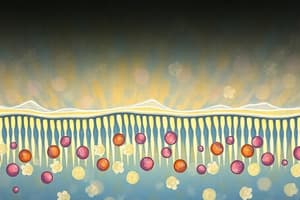Podcast
Questions and Answers
What is the main driving force behind passive transport?
What is the main driving force behind passive transport?
- Energy from cellular ATP
- Carrier proteins
- Concentration gradient (correct)
- Channel proteins
Which process involves the movement of molecules across a membrane without the use of carrier proteins or channel proteins?
Which process involves the movement of molecules across a membrane without the use of carrier proteins or channel proteins?
- Facilitated diffusion
- Simple diffusion (correct)
- Active transport
- Osmosis
What distinguishes facilitated diffusion from simple diffusion?
What distinguishes facilitated diffusion from simple diffusion?
- Requires carrier or channel proteins (correct)
- Occurs in prokaryotic cells only
- Movement against the concentration gradient
- The involvement of cellular energy
In facilitated diffusion, what is the role of channel proteins?
In facilitated diffusion, what is the role of channel proteins?
What is the main difference between carrier proteins and channel proteins?
What is the main difference between carrier proteins and channel proteins?
How does facilitated diffusion differ from active transport?
How does facilitated diffusion differ from active transport?
Which process involves the movement of vesicles across cell membranes?
Which process involves the movement of vesicles across cell membranes?
What is the role of endocytosis in cellular processes?
What is the role of endocytosis in cellular processes?
Why is understanding facilitated diffusion and passive transport important in cellular physiology?
Why is understanding facilitated diffusion and passive transport important in cellular physiology?
Which statement accurately describes active transport?
Which statement accurately describes active transport?
Flashcards are hidden until you start studying
Study Notes
Understanding Passive Transport and Facilitated Diffusion
Ever wondered how cells can move substances across their boundaries without the help of molecular motors or specialized proteins? That's where passive transport and facilitated diffusion come into play—two essential processes that help cells maintain homeostasis and acquire the nutrients they need to thrive.
Passive Transport
Passive transport refers to the spontaneous movement of substances across cell membranes down their concentration gradient, meaning from an area of higher concentration to an area of lower concentration. This process is driven by the energy stored in concentration gradients, and it occurs without the direct input of cellular energy.
Types of Passive Transport
-
Simple diffusion: This process involves the movement of molecules or ions across a membrane without the aid of carrier proteins or membrane channels.
-
Facilitated diffusion: Here, molecules or ions move through carrier proteins or channel proteins embedded within the membrane. These proteins ease the passage of specific substances across the membrane, but they don't use cellular energy to do so.
Facilitated Diffusion
Facilitated diffusion is a type of passive transport, although it requires carrier proteins or channel proteins to function. Carrier proteins bind to the substance and then change their conformation to release the substance on the other side of the membrane, while channel proteins form a selective pore that substances can pass through.
Facilitated Diffusion vs. Active Transport
Unlike facilitated diffusion, active transport involves the movement of molecules or ions against their concentration gradient, which requires energy from cellular sources. Active transport usually involves protein pumps that move substances across the membrane using ATP (adenosine triphosphate) as an energy source.
Exocytosis and Endocytosis
Exocytosis and endocytosis are two other essential processes for maintaining cellular homeostasis, but they differ from passive transport and facilitated diffusion in that they involve the movement of vesicles (containing substances) across cell membranes.
Exocytosis
Exocytosis is the process by which cells release substances stored within vesicles into the extracellular environment. This process helps cells eliminate waste products, release signaling molecules, and deliver newly synthesized proteins and lipids to the extracellular environment.
Endocytosis
Conversely, endocytosis is the process by which cells take substances in from the extracellular environment and incorporate them into the cell. There are several types of endocytosis, including phagocytosis, pinocytosis, and receptor-mediated endocytosis. These processes enable cells to acquire nutrients, remove waste products, and process signaling molecules.
Understanding passive transport, facilitated diffusion, exocytosis, and endocytosis is vital to our knowledge of cellular physiology, as these processes are essential for maintaining cellular homeostasis, acquiring nutrients, and eliminating waste products. did not contain information directly related to the processes discussed in this article.
Studying That Suits You
Use AI to generate personalized quizzes and flashcards to suit your learning preferences.




